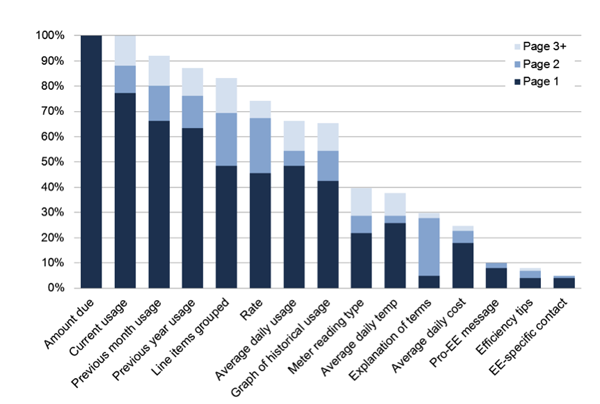Understanding and Connecting Smart Meters, Smart Grids, and Smart Markets.
- Lynne Kiesling
November 10th, 2011
Via the American Council For Energy Efficiency, a very interesting article analyzing what’s on the bills that electric utilities send to their customers. As the report notes, it may be wise – before we jump into discussion of smart meters, smart grids, etc. – for utilities to perhaps start including some basic data to make customers “smart” about their consumption patterns. For example, one-quarter of electric utility bills do not show the rate being charged ($/kWh). And, per the report, very few bills made any mention of energy efficiency. Here is the article itself:
“…Even as smart meters and smart phone apps proliferate, most households still get information about their energy use from a paper bill. Isn’t paper so…2000 years ago?
Well, in some ways, yes. If you will allow a bit of hyperbole, the history of the utility bill seems like an episode out of China’s Warring States period: factions fighting over scraps of territory in an effort to consolidate their power. But, unlike the would-be emperors of ancient China, those fighting over the utility bill seemed to lack an overarching strategy for winning the larger war. The war against energy waste, that is.
Coming back to recent history, research on ways to improve the utility bill so as to give residential customers more control over their energy use has been going on since at least the 1980s. And some of that research seems to have made a difference on the bill, but there is so much more that can be done.
First things first: do you even know what’s on your bill? We didn’t, so we decided to look. After collecting a sample of one hundred bills from utilities all over the country, we found that every bill starts with accounting—dollars, kilowatt-hours (electricity), therms (gas). A good place to start, but not a great place to end, at least as far as customer energy savings are concerned. The following figure shows the results of our analysis, detailed in a new report, The State of the Utility Bill.
Percentage of bills displaying each design element, by page (n=101)
Fortunately, in addition to simple dollars and cents, most bills also provide customers with information they can use to compare their current energy use to previous months, often in graphical format. Such information, in theory, allows people to see the impacts of actions or investments they have taken to save energy, while controlling for seasonal weather patterns. In fact, historical comparisons have been shown to produce modest energy savings. Simple changes such as increasing the frequency of billing from quarterly to monthly, and providing actual rather than estimated consumption information, have also led to savings.
A very small number of utilities seem to be taking a more strategic approach to the bill by including innovative information such as pro-energy efficiency messaging, actionable tips customers can take to save energy, and a specific contact for energy efficiency questions. Using the bill to connect customers with resources they can use to save energy leverages the bill as an established communication device for utilities. There is also some evidence that a more understandable bill reduces calls to customer service and improves customer satisfaction with the bill.
What we didn’t find on any bills was either comparisons of energy use with a peer group, or alternatives to the traditional kWh or therm metrics. Like historical comparisons of a household’s energy use with itself, comparisons with other similar households have produced energy savings of about 2% on average. At present, no utility that we looked at has yet rolled this type of analysis onto its bill, although third-party software companies provide peer comparisons on energy reports as an adjunct to the regular bill.
In addition, alternatives to the traditional metrics were nowhere to be seen on bills here in the United States, although a recent pilot in the UK tested the inclusion of greenhouse gas emissions on the bill, finding that pilot participants had little interest in this type of metric. But, perhaps, as Steve Jobs reportedly said, “It’s not the consumers’ job to know what they want.” Utilities should test, and regulators should support their testing, different bill designs with the goal of delivering customer energy savings.
Why—when sexier, more real-time options are becoming available— would we want to focus on the bill’s potential to help customers control their energy use? Pragmatism, mainly: even if the effect of improved bills on energy use is small in percentage terms, the bill already goes to every customer, so scaling up small individual savings could be significant. And many of the changes that could improve the bill are likely very cheap.
That’s a strategy that Sun Tzu would be proud of.”
This entry was posted on Thursday, November 10th, 2011 at 6:51 pm and is filed under Uncategorized. You can follow any responses to this entry through the RSS 2.0 feed. You can leave a response, or trackback from your own site.
Leave a Reply
You must be logged in to post a comment.
Based on decades of experience and interest in conservation, Monty Simus believes that a truly “smart” grid must be a “transactive” grid, unshackled from its current status as a so-called “natural monopoly.”
In short, an unlocked grid must adopt and harness the power of markets to incentivize individual users, linked to each other on a large scale, who change consumptive behavior in creative ways that drive efficiency and bring equity to use of the planet's finite and increasingly scarce resources.
